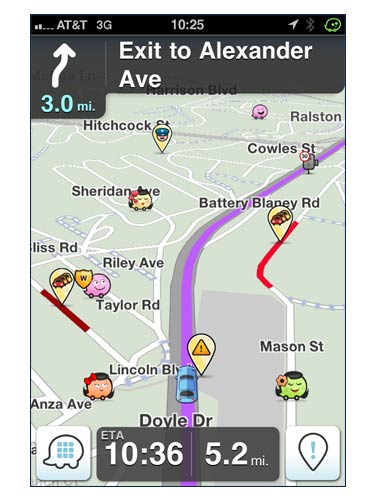By Avigayil Kadesh
On Friday, November 2, an official from the US Department of Energy contacted the California offices of the popular Israeli navigation app
Waze, asking for help.
Following the punishing effects of Hurricane Sandy, drivers in the most affected areas were experiencing difficulty finding working gas stations, and even when they found an open station the cars were lined up for blocks.
“They told us they have a big headache in New Jersey because of huge gas lines, and they thought of crowd-sourcing to help,” says Waze VP Community and Operations Fej Shmuelevitz. “The Department of Energy and the White House wanted to know if we had enough customers to gather the data needed by the public.”
Waze certainly does. Launched on a small scale in 2008, Waze now has nearly 30 million mobile app users (“Wazers”) who tap into its crowd-sourced data for driving directions based on the phone’s built-in GPS.

Waze helped car owners navigate in real time
to fill-up stations with shorter lines.
Shmuelevitz responded quickly by filtering messages out to users.
“We uploaded the live gas stations that had fuel, so Wazers could see them and write inside the system about the queues and the supply of gas. We transferred that information to the live Google Crisis Map set up with the government, where people could post about which stations had gas and electricity.”
It proved so useful that the effort was extended beyond New Jersey into hard-hit areas of New York and Pennsylvania as well. It reportedly also helped government agencies direct gasoline deliveries to where they were needed most.
“We took a very big area and got relevant messages from Wazers,” says Shmuelevitz. “Hundreds of people per hour participated; probably several thousand altogether. People did navigate to the stations that we indicated had fuel and short lines.”
Now the crisis is past, but Waze is pleased that its system stood up to the test.
“We’re very happy that we could help in the small way we did, and prove that crowd-sourcing is an efficient and beneficial method to provide real-time information to help in times of crisis,” says Shmuelevitz, speaking from Palo Alto, California.
Di-Ann Eisnor, Waze’s VP of platforms and partnerships, told a reporter from Gigaom.com that she foresees more opportunities for systems such as Waze to work with government agencies to relay “amber alerts” or route traffic around trouble spots. Waze, she added, will likely work on how to pass data directly on to the government during emergencies.